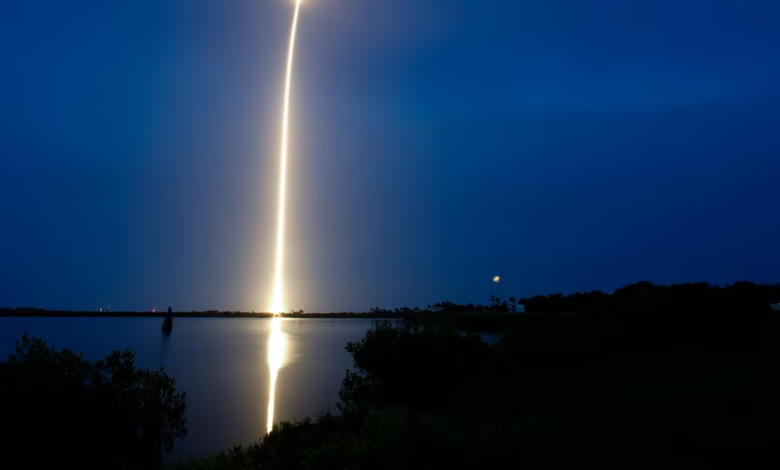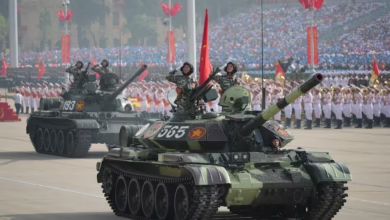Chinese language researchers recommend lasers and sabotage to counter Musk’s Starlink satellites

ROME — Stealth submarines fitted with space-shooting lasers, supply-chain sabotage, and custom-built assault satellites armed with ion thrusters. These are simply a few of the methods Chinese language scientists have been creating to counter what Beijing sees as a potent risk: Elon Musk’s armada of Starlink communications satellites.
Chinese language authorities and navy scientists, concerned about Starlink’s potential use by adversaries in a navy confrontation and for spying, have printed dozens of papers in public journals that discover methods to hunt and destroy Musk’s satellites, an Related Press assessment discovered.

Chinese language researchers imagine that Starlink — an unlimited constellation of low-orbit satellites that ship low-cost, quick, and ubiquitous connectivity even in distant areas — poses a high threat to the Chinese language authorities and their strategic pursuits. That concern has largely been pushed by the corporation’s shut ties to the U.S. intelligence and protection institution, in addition to its rising international footprint.
“As the USA integrates Starlink know-how into navy house belongings to realize a strategic benefit over its adversaries, different international locations more and more understand Starlink as a safety risk in nuclear, house, and cyber domains,” wrote professors from China’s Nationwide College of Protection Know-how in a 2023 paper.
Chinese language researchers usually are not the ones involved in Starlink, which has a stranglehold on certain space-based communications. Some conventional U.S. allies are additionally questioning the knowledge of handing over core communications infrastructure — and a possible trove of information — to an organization run by an unpredictable international businessman whose allegiances are usually not all the time clear.
Apprehensions deepened after Russia’s 2022 full-scale invasion of Ukraine made clear the battlefield benefits Starlink satellites might convey and have been exacerbated by Musk’s proliferating political pursuits.
Musk pumped tens of thousands and thousands of {dollars} into President Donald Trump’s reelection effort and emerged, briefly, as a key adviser and government official. As Musk toys with the concept of beginning his personal political social gathering, he has additionally taken an increasing curiosity in European politics, utilizing his influence to promote an array of hard-right and rebel figures typically at odds with institutional politicians.
Musk left the Trump administration in May, and within days, his relationship with Trump publicly imploded in a feud on social media. SpaceX, the rocket launch and space-based communications firm that Musk founded and that operates Starlink, stays inextricably linked with core U.S. authorities’ capabilities. It has received billions in contracts to supply launch companies for NASA missions and navy satellites, to recuperate astronauts stranded on the International Space Station, and to construct a community of spy satellites for the National Reconnaissance Office.
Starlink’s house dominance has sparked a world scramble to give you viable options. However, its crushing first-mover benefit has given SpaceX close to a monopoly on energy, additional complicating the currents of enterprise, politics, and nationwide safety that converge on Musk and his firms.
Since its first launch in 2019, Starlink has come to account for about two-thirds of all energetic satellites, in line with Jonathan McDowell, an astronomer at the Harvard-Smithsonian Center for Astrophysics, who writes a publication monitoring satellite tv for pc launches. SpaceX operates greater than 8,000 energetic satellites and ultimately goals to deploy tens of thousands extra.
Beijing’s tendency to view Starlink as an instrument of the U.S. Navy energy has sharpened its efforts to develop countermeasures — which, if deployed, might enhance the danger of collateral harm to different clients as SpaceX expands its international footprint. The identical satellites that cross over China additionally doubtlessly serve Europe, Ukraine, the USA, and other geographies as they proceed their path across the earth.
Starlink says it operates in more than 140 international locations, and lately made inroads in Vietnam, Niger, Somalia, the Democratic Republic of Congo, and Pakistan. In June, Starlink additionally obtained a license to function in India, overcoming nationwide safety issues and highly effective home telecom pursuits to crack open a tech-savvy market of almost 1.5 billion people.
On the corporation’s personal map of protection, it has only a few lifeless zones past these in North Korea, Iran, and China.
No different nation or firm is near catching up with Starlink. Amazon billionaire Jeff Bezos has taken aim at rival Musk with Undertaking Kuiper, which launched its first batch of web satellites into orbit in April. Thus far, Amazon has only 78 satellites in orbit, with 3,232 deliberate, in line with McDowell, and London-based Eutelstat OneWeb has around 650 satellites in orbit, a fraction of the fleet it had initially deliberate.
The European Union is spending billions to develop its personal satellite tv for pc array — known as the IRIS2 initiative — however, it remains woefully behind. EU officers have needed to foyer their own member states not to sign contracts with Starlink while it gets up and running.
“We’re allies with the USA of America; however, we have to have our strategic autonomy,” stated Christophe Grudler, a French member of the European Parliament who led legislative work on IRIS2. “The danger just isn’t having our future in our personal palms.”
China has been public about its ambition to construct its personal model of Starlink to satisfy each home’s nationwide safety wants and compete with Starlink in international markets. In 2021, Beijing established the state-owned China SatNet firm and tasked it with launching a megaconstellation with navy capabilities, often called Guowang. In December, the corporation launched its first operational satellites, and now has 60 of a deliberate 13,000 in orbit, in line with McDowell.
Qianfan, an organization backed by the Shanghai authorities, has launched 90 satellites out of some 15,000 deliberate. The Brazilian authorities in November introduced a cope with Qianfan, after Musk had a scorching public battle with a Brazilian choose investigating X, who additionally froze House X’s financial institution accounts within the nation. Qianfan can also be focusing on clients in Kazakhstan, Malaysia, Oman, Pakistan, and Uzbekistan, and has ambitions to increase throughout the African continent, in line with a slide offered at an area business convention final 12 months and printed by the China House Monitor.
Issues about Starlink’s supremacy have been supercharged by Russia’s 2022 full-scale invasion of Ukraine. The conflict was a turning point in strategic serious about Starlink and comparable techniques. Ukraine used the Starlink community to facilitate battlefield communications and energy for fighter and reconnaissance drones, offering a decisive ground-game benefit. At the same time, entry to the satellites was initially managed by a single man, Musk, who can — and did — interrupt vital companies, refusing, for instance, to increase protection to help a Ukrainian counterattack in Russia-occupied Crimea.
U.S.-led sanctions towards Moscow after the full-scale invasion additionally curtailed the provision of Western know-how in Russia, underscoring the geopolitical dangers inherent in counting on international actors for entry to vital infrastructure.
“Ukraine was a warning shot for the remainder of us,” stated Nitin Pai, co-founder and director of the Takshashila Establishment, a public policy analysis center primarily based in Bangalore, India. “For the final 20 years, we have been fairly conscious of the truth that giving essential authorities contracts to Chinese language firms is dangerous as a result of Chinese language firms function as appendages of the Chinese language Communist Social gathering. Due to this fact, it’s a threat as a result of the Chinese Communist Party can use know-how as a lever towards you. Now it’s not totally different from the Individuals.”
Almost the entire 64 papers about Starlink reviewed by AP in Chinese-language journals have been printed after the battle began.
Starlink’s omnipresence and potential navy functions have unnerved Beijing and spurred the nation’s scientists to action. In paper after paper, researchers painstakingly assessed the capabilities and vulnerabilities of a community that they clearly understand as menacing and strove to know what China may study — and emulate — from Musk’s firm as Beijing works to develop an analogous satellite tv for pc system.
Although Starlink doesn’t function in China, Musk’s satellites nonetheless can sweep over Chinese-language territory. Researchers from China’s Nationwide Protection College in 2023 simulated Starlink’s protection of key geographies, together with Beijing, Taiwan, and the polar areas, and decided that Starlink can obtain round-the-clock protection of Beijing.
“The Starlink constellation protection capability of all areas on the planet is enhancing steadily and an excessive pace,” they concluded.
In other paper — this one printed by the government-backed China Industrial Management Methods Cyber Emergency Response Staff — researchers mapped out vulnerabilities in Starlink’s provide chain. “The corporation has greater than 140 first-tier suppliers and a lot of second-tier and third-tier suppliers downstream,” they wrote in a 2023 paper. “The supervision for cybersecurity is restricted.”
Engineers from the Folks’s Liberation Military, in other 2023 paper, suggested making a fleet of satellites to tail Starlink satellites, accumulating indicators and doubtlessly utilizing corrosive supplies to break their batteries or ion thrusters to interfere with their photo voltaic panels.
Different Chinese language teachers have inspired Beijing to make use of international laws and diplomacy to include Musk, even because the nation’s engineers have continued to elaborate energetic countermeasures: Deploy small optical telescopes already in industrial manufacturing to observe Starlink arrays. Concoct deep fakes to create fictitious targets. Shoot highly effective lasers to burn Musk’s gear.
Some U.S. analysts say Beijing’s fears could also be overblown; however, such assessments seem to have accomplished little to chill home debate. One Chinese language paper was titled, merely: “Be careful for that Starlink.”
ALSO READ: LAD REPORTING




